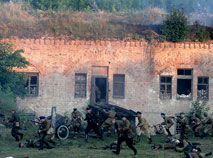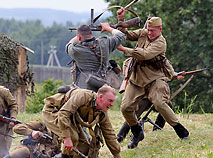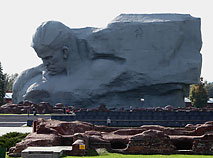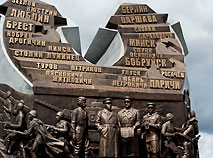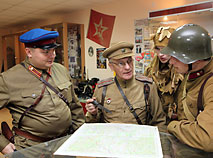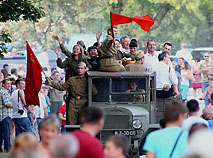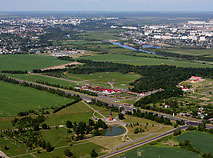Great Patriotic War in Belarus
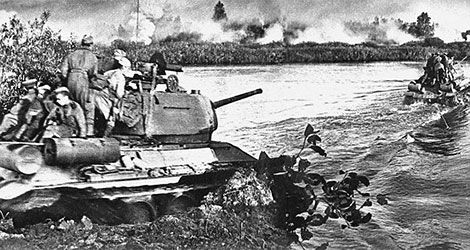
During the Great Patriotic War Belarus lost every third resident. But the half-ruined wounded country would not surrender. Many decades later, the memory of the people who made the greatest contribution to the victory over fascism remains sacred.
Among 34.4 million Soviet soldiers who took part in the battles on the fronts of the Great Patriotic War, more than 1.3 million were Belarusians and natives of Belarus.
In Belarus the Great Patriotic War (22 June 1941 – 9 May 1945) lasted 3 years, 1 month and 6 days from 22 June 1941 till 28 July 1944. Big battles and military operations on the Belarusian land included:
-
the heroic defense of Brest fortress in the first days of the war;
-
defense of Mogilev which would not surrender for 23 days and nights;
-
Bagration, one of the greatest offensive operations in the history of mankind...
Nazi-occupied Belarus had Europe’s largest partisan and underground movement. There were over 374,000 partisans and over 70,000 members of the anti-fascist underground movement in Belarus.
The first partisan battle of the World War II took place around Pinsk on 28 June 1941. The operation was undertaken by the partisan team led by the legendary commander Vasily Korzh.
Belarusian Tikhon Bumazhkov and Fyodor Pavlovsky became the first partisans awarded the titles Hero of the USSR in 1941.
In July 1943 partisans conducted the biggest act of sabotage at the railway station Osipovichi, blowing up four German echelons with ammunition and Tiger tanks. One of the biggest partisan battles in the history of the war was the Battle of Polotsk and Lepel in 1944.
By late 1943 partisans controlled 108,000km, almost 60% of the occupied territory. Among the biggest partisan zones were zones in Klichev, Polotsk and Lepel, and near Vitebsk…
Europe’s biggest urban anti-Nazi underground resistance during the Great Patriotic War was in the Belarusian Minsk.
The operation to liquidate Hitler’s henchman, gauleiter Wilhelm Kube, became one of the brightest pages in the history of the Minsk resistance. In the early morning hours of 22 September 1943 the executioner of hundreds of thousands of people was assassinated by a time bomb hidden in his mattress.
Years later this story made the basis for the well-known Soviet film Clock Stopped at Midnight, the first movie about the heroes of the Minsk underground resistance…
Despite the people’s heroic resistance, Belarus, being in the way of the German Nazi army, sustained irreplaceable losses during the war…
As many as 209 out of 270 Belarusian cities and towns were destroyed and devastated. The Nazis conducted over 140 punitive operations that partially or completely destroyed 5,454 villages on the territory of Belarus.
Hundreds of Belarusian villages shared the fate of Khatyn which was burnt down together with its inhabitants and which became the symbol of those atrocities…
More than 260 death camps and places of mass killings were set up in Belarus. The infamous list includes:
-
Trostenets extermination camp, the fourth largest death camp in Europe where over 200,000 people were murdered. There is evidence which suggests that the actual number of the victims was much higher, around 546,000 people;
-
children's death camp in the village of Krasny Bereg where the Nazis pumped the blood out of children for the needs of German hospitals in the most cruel ways;
-
Ozarichi death zone where the Nazi kept under the open sky thousands of people suffering from typhus in order to use them as a bacteriological weapon against the approaching Red Army…
Incomplete data indicates that around 1.5 million people were murdered in the Nazi death camps on the territory of Belarus. Among the victims there were locals and also people brought from Austria, Poland, Czechoslovakia, France, and Germany…
***
It took Belarus many years to recover from that horrible war. Belarusian people preserve the sacred memory of the victims of the Nazi regime and always remember the valor and heroism of the people who lived in those hard times and gave everything they had for the Great Victory.
Every year Belarus hosts numerous events dedicated to the Great Patriotic War. Impressive memorial complexes and monuments have been built in the places of heroic battles and people’s tragedies, unique historical routes have been developed.
Expositions about the war are organized in all towns and cites of the country. The world’s first Museum of the Great Patriotic War History in Minsk is the main storage of rare exhibits.
Battle and historical reenactments take place all over Belarus to mark memorable anniversaries of the beginning of the war, Bagration Operation and, of course, Victory Day.
Such reenactments are held in Brest Hero Fortress and at Stalin’s Line near Minsk, in Mogilev (the Battle in Buinichi Field), Vitebsk, Gomel (the Battle of the Dnieper), on the Augustow Canal near Grodno, in other towns of the country.
During a trip to Belarus you will see how local people cherish the memory of the Great Patriotic War and peace which was won at the cost of millions of lives…







 print version
print version make home page
make home page add to bookmarks
add to bookmarks
